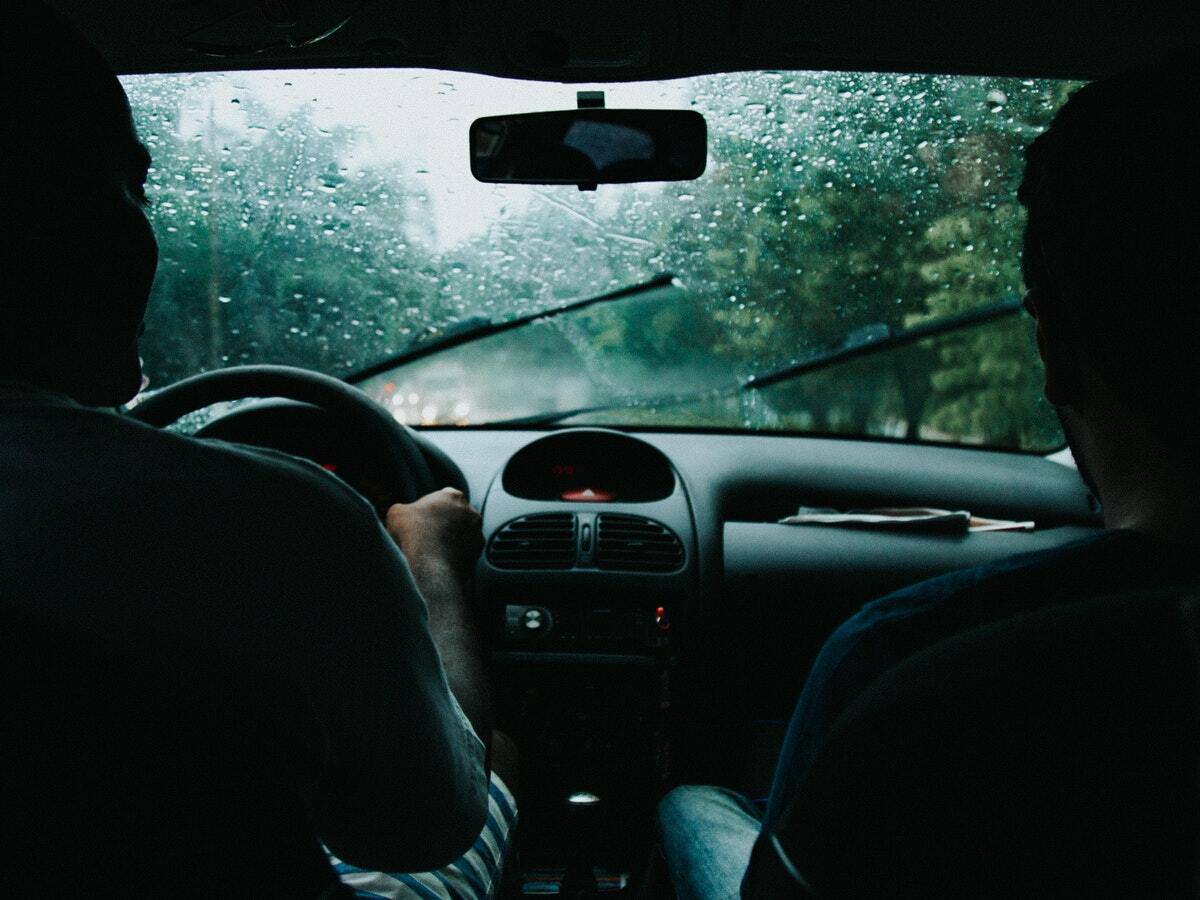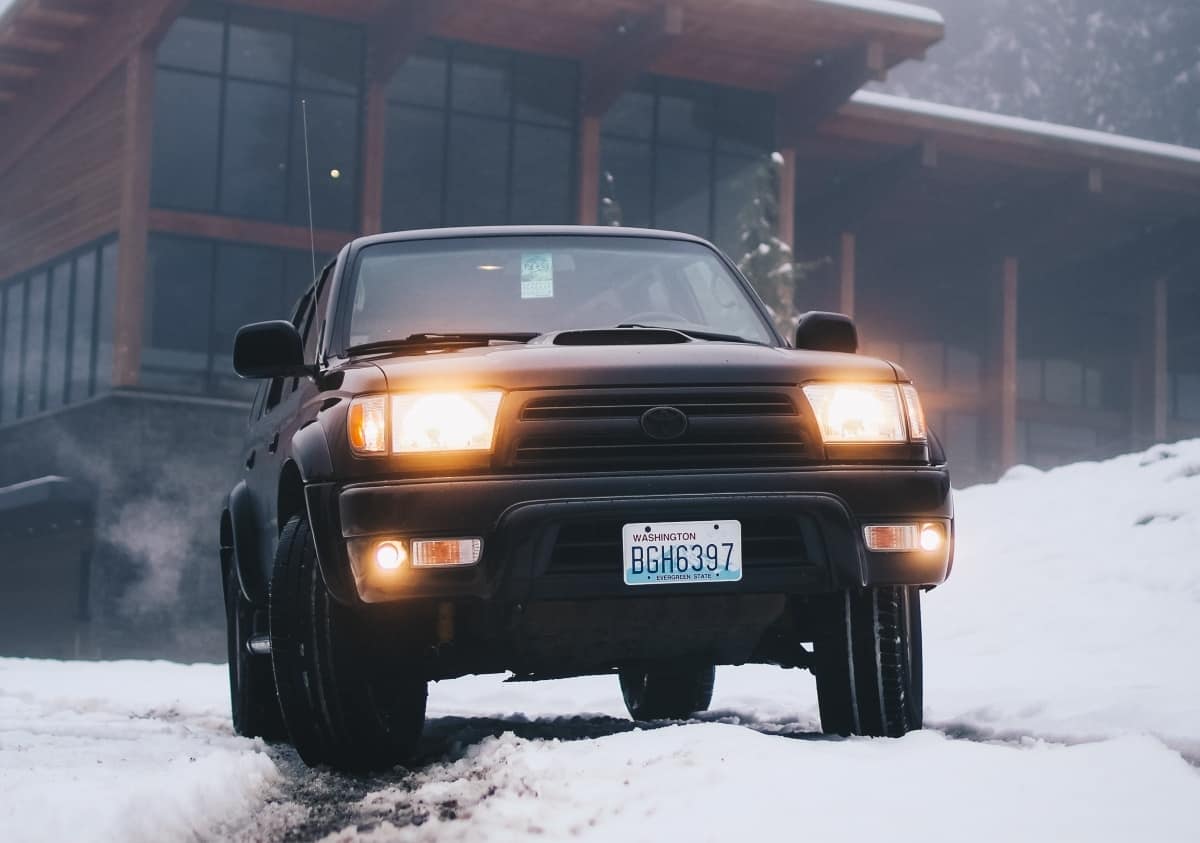Driving in the snow requires more care and precaution than summer driving. The fluffy, cold gift from mother nature often makes the roads slippery and difficult to navigate. However, snowfall doesn’t mean driving on the road is completely out of the question. All you need is a little caution and to follow the suggestions within this article. Here are ten simple tips to keep you and your family safe while driving in the snow this winter.
1. Clear Off Headlamps
One of the first tips for driving in the snow is to clear off your vehicle’s headlamps.
Clean headlamps are especially important when driving in snow. Days are shorter and it gets dark sooner. Ice and snow easily build up on headlamps. You’re more likely to have an accident if your headlamps are dim. The efficiency of headlamps can be compromised even when you think they are working.
Stay safe on the snowy roads by clearing off your headlamps every time you go out in winter. But don’t use an ice scraper on headlamps, as this can cause scratches. Instead, use a soft cloth and an ice melt solution to get rid of frozen snow and ice.

2. Use Winter Tires
It’s not recommended to use summer tires while driving in snow. If you’ve been driving all summer on your tires, chances are the tread has been significantly worn. As soon as temperatures cool down, head to your tire shop and get winter tires.
Winter tires have thicker tread that’s ideal for driving in the snow. You can also opt for all-season tires, which are built to ride out both the summer and winter. However, winter tires are more durable and therefore superior to all-season tires for driving in snow.
Finally, always use four winter tires, not just two, even if you don’t have all-wheel drive.
3. Consider Using Tire Chains
Depending upon where you live, you might need to use tire chains. Tire chains offer additional traction on heavy, deep snow. Tire chains are appropriate if you’re driving on unplowed roads, country roads, or mountainous terrain.
For example, if you have a winter cabin that you’re visiting, you’ll want to use tire chains as soon as you exit off the highway. You may need to practice installing and removing your tire chains before you drive. This will make it easier for you when you have to put them on in snowy conditions.
4. Leave Plenty of Time to Arrive
If you have some place where you have to be at a certain time, give yourself plenty of time to arrive. Getting to places on time is always important, but while you may have been able to commute in a shorter period of time in the warmer months, you need to leave more time in the winter to get there. If you don’t, you’ll be tempted to drive faster than is safe and your risk of having an accident will increase.
Also remember that you have to not only allow for slower speeds; you also have to be on the lookout for a higher incidence of road accidents, which can cause further delays. A good rule of thumb is to allow for twice as long as it would normally take you to arrive.

5. Invest in New Windshield Wipers
Snowy conditions can easily make it hard for your windshield wipers to keep up. Before the first snowfall, invest in new windshield wipers. Not sure where to start looking for new windshield wipers? You can:
- purchase at any auto supply shop
- install them in less than five minutes
- have the auto shop salesperson install them for you
6. Increase Following Distance
Ordinarily, the guidelines set out in your state’s driving manual will give you a safe following distance. But when driving in the snow, you’ll need more time and distance to avoid running into the car in front of you.
Remember that there are more road accidents in winter. It’s more likely that a car in front of you will stop suddenly. When driving in the snow, double the following distance that you normally use in summer.
7. Clear Exhaust Pipe
As you drive in snow, the snow and slush get kicked up onto the sideboards and underside of your car. Snow and slush can also accumulate in and around the tailpipe.
When this happens, dangerous carbon monoxide can enter the cabin of your vehicle. Every time you get in your vehicle to drive in the winter, take a look at the exhaust pipe and clear out any snow or slush that you see.
8. Learn How to Brake
When looking for tips for driving in the snow, remember that there may be a layer of ice under the snow.
You should always drive in winter with the assumption that there is ice. Therefore, you need to learn how to brake on slippery roads. Never slam your brakes on! Instead, tap your brakes to avoid skidding out of control. This is good practice, even if you have anti-lock brakes.
9. Don’t Accelerate on Hills
When driving up and down hills on snowy roads, avoid “powering up” in order to get up the hill faster.
This is dangerous because when you reach the top you may not be able to safely slow down. This means you’d be going down the other side of a hill at an increased rate of speed. Instead, use a consistent and steady speed going up, slow down at the top and then carefully descend on the other side.

10. Stay Home When Possible
Finally, avoid driving in snow as much as possible. Consider having essentials like groceries delivered. Or stock up on the necessities ahead of time. Ask your boss if you can work from home on bad days. The best prevention is avoidance. So bundle up inside and try to make the best out of your snow day.
Have Protection Against Any Weather With Insurance
If you keep in mind all these simple tips for driving in the snow, you’ll very likely be able to avoid an accident this winter. However, the best way to have roadside safety in your vehicle is with auto insurance.


